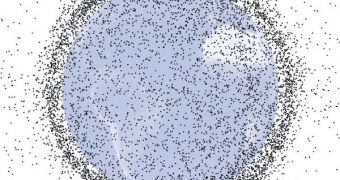Scientists from the National Aeronautics and Space Administration (NASA) and the Defense Advanced Research Projects Agency (DARPA) are currently meeting to discuss the challenges associated with cleaning up the Earth's orbit. The talks are scheduled to take place between December 8-10, in Chantilly, Va, and they are named the first International Conference on Orbital Debris Removal. Space agencies and private companies have come to realize the enormous dangers the tens of thousands of pieces of space junk pose to their interests in low-Earth orbit, and are currently looking for ways to get rid of them.
When it comes to the things the orbit contains, every “need” can be satisfied. Experts reveal that you can find anything from satellites' pieces to lens caps, from anti-satellite testing remains to spent rocket stages, and from clamp bands and paint chips to debris from colliding satellites. In all, some 19,000 man-made objects larger than four inches (ten centimeters) in diameter are spinning around the planet, and each of them has the ability to cause massive damage to satellites or the International Space Station (ISS). The thing is that all these objects are located in low-Earth orbit, where the ISS and shuttles fly.
“We have also evaluated the feasibility of numerous concepts proposed by other US government organizations, the aerospace industry, academia, and the general public. To date, none of the techniques examined have proven entirely practical due to technical and/or economic reasons,” NASA Johnson Space Center Orbital Debris Program Office chief scientist Nicholas Johnson said. “To preserve the near-Earth space environment for the farther term, the removal of large debris... derelict spacecraft and launch vehicle stages, is required. Consequently, a variety of orbital debris removal techniques will likely be necessary to handle the entire spectrum of orbital debris sizes at all altitudes,” he added.
The new meeting will see presentations from the United States, Russia, France, Germany, and Japan be made, as researchers attempt to propose more and more methods of making the low-Earth orbit a safe place again. The conference again highlights the fact that only a joint effort can ensure that success is achieved in this endeavor. “This is a tragedy of the commons kind of thing. No one country is responsible for cleaning up space,” the President of the Mount Pleasant, S.C.-based Star Technology and Research, Inc., Jerome Pearson, shared, quoted by Space.
“From the predictions I've seen of how the space debris population will grow in the coming years, it looks like the space community will need to take active measures soon to clean up at least some of the existing debris, or the problem could get away from us,” the leader of the Bothell, Washington-based Tethers Unlimited, Inc., Robert Hoyt, explained. “The question has always been who is going to pay to clean up the mess? Nobody really wants to get stuck with that bill.”

 14 DAY TRIAL //
14 DAY TRIAL //